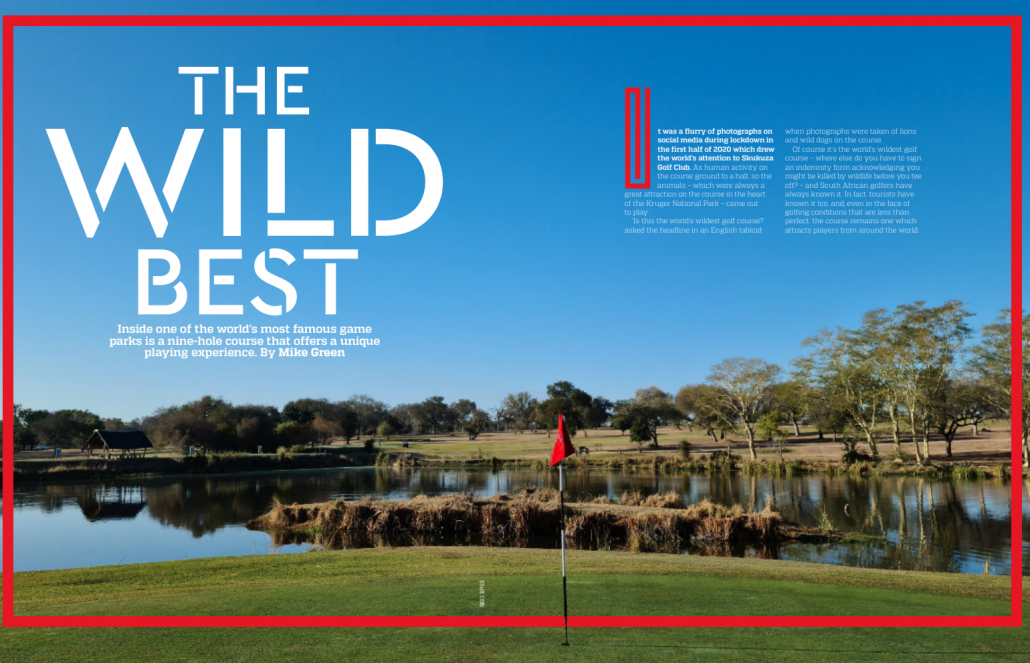It was a flurry of photographs on social media during the lockdown in the first half of 2020 which drew the world’s attention to Skukuza Golf Club.
As human activity on the course ground to a halt, so the animals – which were always a great attraction on the course in the heart of the Kruger National Park – came out to play.
‘Is this the world’s wildest golf course?’ asked the headline in an English tabloid when photos were taken of lions and wild dogs on the course.
Of course it’s the world’s wildest golf course – where else do you have to sign an indemnity form acknowledging you might be killed by wildlife before you tee off? – and South African golfers have always known it. In fact, tourists have known it too, and, even in the face of golfing conditions that are less than perfect, the course remains one which attracts players from around the world.
And, despite knowing more about wildlife than most, South African golfers are not immune to underestimating some of the dangers of playing on a course where the animals are likely to play by a set of rules all their own: In 2014, a player was killed by a crocodile while retrieving golf balls from Lake Panic, around which the course meanders.
READ: COTM January 2021: Raising the bar
And while victim-blaming would seem to be a logical response when a son of people who had worked in the Kruger Park for years is taken while waist-deep in water in which it is known there are crocodiles (amongst other things!), the fact is anyone can get taken by surprise by animals whose modus operandi is stealth.
Course superintendent Jean Rossouw was called by a worker one morning because there was a leopard near one of the greens. ‘I thought I’d better get there because there were players out on the course,’ he recalls. ‘We drove there on a buggy, and as we got closer, I saw a lion. I was about to give the guy grief for not knowing the difference between a lion and a leopard when he pointed out I was looking at the wrong animal. I turned and saw the leopard nearby in a crouch.’
It was an incident which could have ended in tears, and Rossouw has documented hundreds of such incidents: In an extraordinary run described by The Lowvelder newspaper from the beginning of August to the end of September last year, he shared pictures of hippos confronting each other near the first tee, of a hyena with a catfish strolling down a fairway, a lion on the third tee and fairway, elephants crossing a fairway and then drinking from the water of Lake Panic, and some giraffe making their way around the place. The period was bookended when a dead hippo was discovered floating in the water near the 18th tee, killed by another hippo.
The challenges of maintaining a course in the face of the damage that can be caused by animals are immense, yet the course remains an intriguing and playable experience.
The course is a nine-hole (18 tees), par 72, and is 5 831m for men and 4 950m for women. It has no bunkers, although ‘aerial bunkers’ abound because of the many trees.
Your first encounter with trees comes on the 1st and 10th, with some pesky specimens right in the middle of the fairway. It means your tee shot has to be fairly precise, especially with Lake Panic (and hippos) on your left and out-of-bounds stakes to your right. Your approach to the water-protected green needs to be pretty accurate too.
The par-three 2nd/11th is short at 126 and 129m (109 for women), but with a small green and water left and behind, you have to have the right club in your hand. And don’t even think of searching for a ball that goes over into the reeds – peering earnestly from a safe distance should be enough to convince you to go to the well-used drop zone.
Next comes the first of the par-fives: The 3rd/12th has a quaintly named stream running across it into Lake Panic, and it’s frustratingly in play for those slightly shorter than they’d like to be off the tee. It’s called ‘Bok Dood Geslaan Groot Geskrik Spruit’ (Killed Buck and Got A Huge Fright Stream), after a local gummed a shot and hit a grazing impala. The buck went down, and as the players approached, a lion emerged from the bush to carry off its bonus meal.
It’s downhill for the first 250m and then the next 250m takes a dog-leg to the left and is slightly uphill with the dam all the way from the tee box on the left and out of bounds all the way on the right, with a two-tiered green. Hole 12 is slightly shorter.
The par-four 4th is the stroke-one on the course. It is uphill over 400 metres, with out-of-bounds running all the way on the right-hand side. The 13th’s tee box way back on Lake Panic’s dam wall, and it becomes a much easier par five.
The 5th is the second par-five, and it looks deceptively simple: a straight hole downhill, with a few large marula trees obstructing your drive and approach shots. Hole 14 becomes a par-four.
Holes 6 and 15 are fairly difficult par-fours, with a slight dog-leg to the right, uphill most of the way with a couple of trees in your landing areas, and thick bush at the back of the green without any hazards.
READ: February issue on sale now!
The 7th and 16th are short dog-leg right par-fours, where the long hitters can drive the green if they cut the corner with a ‘Tiger line’ tee shot over the out-of-bounds stakes running all the way on the right-hand side of the hole along the tar road to the green.
The 8th and 17th are fairly straight par-fours, going downhill with a blind tee shot. It is also driveable for the long hitters, with out-of-bounds to the right and red stakes to the right-hand side of the green.
The 9th and 18th form the signature hole of the course (see page 59).
How did this pleasant tour of the African bush, with its exposure to a wildlife experience second to none, come about?
There were no sporting facilities for staff of the Kruger National Park until after World War II, and during the 1950s and 1960s, the community hall and adjacent sporting facilities at Skukuza, the biggest rest camp in the park, were developed.
In the late ’60s, Kruger Park golfers had to travel the narrow dirt roads via Numbi Gate to play a round at Sabie River Bungalows in Hazyview. It was then that it became clear that a few short holes around the rugby field would make matters a lot easier for them.
Golf quickly found its niche in Skukuza and it became apparent that there would have to be something more than just makeshift holes for those who so badly wanted to play. A disused landing strip adjacent to the camp was cleared and preparation began.
That consisted mainly of clearing open areas to be used as tees and some as greens. The first there were six greens, or rather ‘browns’, which had to be levelled before play by dragging hessian bags over them. Later a further three greens were added.
On 12 June 1971 the first six players teed off on what was the forerunner of the Skukuza Golf Club. On 23 October 1971, the founding meeting of the Skukuza Golf Club was held, with 19 members, including five ladies, present.
Watch: Elephant on Skukuza fairways
The area across the tar road running next to the seventh fairway, which is now under housing, saw the first part of the golf course being developed. Step by step, five greens were completed and with a few adaptations, nine holes could be fitted into this small area.
Towards the beginning of 1984 an automated irrigation system on the course was installed with the assistance of the local members. This obviated the moving of the sprinklers umpteen times a day.
Soon the membership of the club exceeded expectations and it became apparent that the clubhouse and its facilities were not sufficient. The park warden at the time, Dr Salomon Joubert, a very keen golfer himself, agreed to the construction of a larger clubhouse.
At that point, it was decided that the area on which three holes of the original course remained was to be used for new staff housing. The Parks Board agreed to develop three new holes which were built on the opposite side of Lake Panic and which created the opportunity of also constructing the new clubhouse on that side of the lake.
Since the Skukuza Golf Club came into being, the course and its facilities were only available to the members of the club, Parks Board staff and invited guests. After all those years, pressure was brought to bear on the committee to open the course to the public, which was done on 15 November 1999.
The club has played host to the likes of former South African president FW de Klerk, the Crown Prince of Malaysia, and golfing legends such as Hugh Baiocchi, Mark McNulty, Bobby Lincoln, John Bland, Tony Johnstone, Dale Hayes, Mark Wilshire, Jeff Hawkes, Joe Dlamini, Trevor Dodds as well as the present course-record holders Wayne Westner and Phil Simmons.
The way ahead lies in the hands of the weather gods as well as benefactors. Maintaining the course in the face of the kind of damage wild animals can cause in a drought is an impossible task. Recent rains have the course looking lush and green. But, without the equipment like modern fairway mowers and green mowers, and without access to the kind of technology that can keep greens in good condition, it’s a constant battle.







